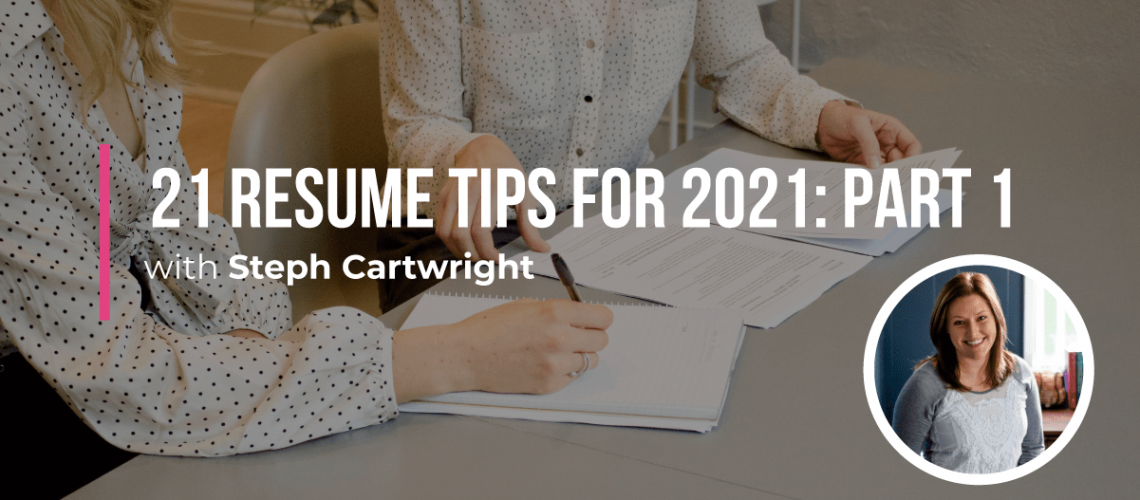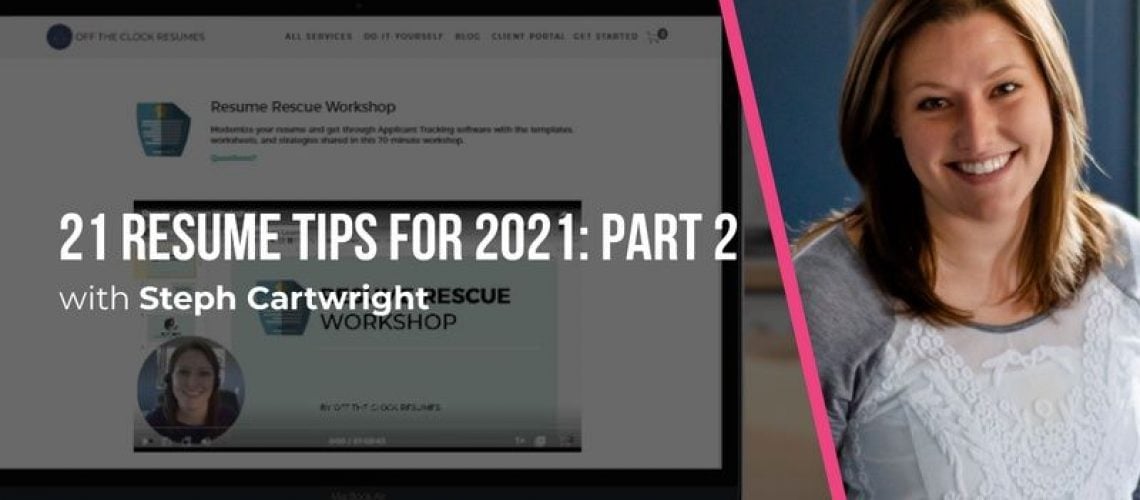What’s keeping you from updating your resume?
There are few worse scenarios in life than this...
You dread going to work every morning. You do it because you need to pay the bills and chip away at that looming debt you’re reminded of with every monthly statement.
You get an email or text from an old friend, former co-worker, or industry connection that you made years ago about a job opening with a company you’ve been discreetly stalking online for weeks. All you need to do is send over your resume or apply online tonight, and the job is practically yours.
It only takes one look at your resume, and you feel defeated. You haven’t touched it in years. It doesn’t even have your most recent job listed, and it’s overall look and feel hasn’t changed much over time. You’re pretty sure it looks as ineffective as you feel after a long day at work.
I want to help. I've assembled my top resume tips for 2021 to guide you through, updating, revamping, and ultimately crafting a job-winning resume that gets you hired faster. Let's start with the basics for how to design and position yourself as the best fit for the job that you want on paper first.
Stuck in your job search?
Find and apply to your next job today.
Click Here
1 | Understand Your Resume’s Role In The Hiring Process
The #1 complaint from job seekers in the last five years has been, “My resume isn’t getting in front of the right people!” I get how frustrating, time-consuming, and often discouraging looking and applying for jobs online can be. Understanding your resume’s role in the hiring process is the first step to creating a job-winning resume that gets you unstuck and moving forward confidently.
Granted this can vary depending on company size and industry, here’s the SparkNotes version of the typical hiring process:
- A team leader or manager realizes they need to create or fill a position and notifies the HR team.
- Someone on that HR team creates a job description based on the team leader/manager’s needs and posts it to the company’s Applicant Tracking System (also known as ATS) which is linked to the company’s Careers page.
- The HR staff member then posts the job to job boards as well as LinkedIn, ZipRecruiter, Glassdoor, and other sites depending on their budget.
- The Applicant Tracking software collects resumes and applications from hundreds of job seekers, comparing resumes to the job posting as well as ranking the top qualified candidates based on keywords from the resumes and “knock-out” questions from the applications.
- The top qualified candidates (maybe the top 10) will have their resumes looked at by the HR team who will have their own checklist of requirements and preferences.
- Out of the resumes seen, the top candidates (maybe the top 6) will get phone screening interviews.
- Out of the candidates screened, the top candidates (maybe the top 4) will have their resumes forwarded to that team leader or manager to be considered for an in-person interview.
- Out of the interviewed candidates, the top candidate (maybe more depending on the hiring circumstances) will get the job offer.
2 | Write For All Readers, Not Just Bots
Now that you understand your resume’s role in the hiring process, you can see that your resume needs to get through an Applicant Tracking system and two other gateways before you are selected for a job interview. A common misconception about resume writing is that your top priority has to be writing your resume for computers or the bots that operate within ATS.
Resume writing is actually a balancing act. You have to write your resume for three different audiences: ATS, HR, and a direct supervisor or hiring manager deciding who will get the interview.
ATS is looking at both the digital formatting of your resume and the keywords you’ve included throughout. The HR reader likely has a checklist of requirements and preferences, so you can’t assume this person will know that you have certain skills and experience based on your job titles. A direct supervisor or hiring manager will then need to decide who is a better fit for the job, the team, and the company as a whole among the handful of applicants that made it this far in the process.
3 | Narrow Down Your Job Target
The most effective, job-winning resume is going to be targeted for a specific job. If you’re applying for jobs online, this means the specific job posting. If you’re networking, this means you need to get laser-focused on what your job target is to position yourself as the best fit for the job that you want.
Targeting your resume shows that you understand the goals of the role you’re applying for or pursuing in your job search. A targeted resume will also demonstrate that you can meet and exceed those goals based on your track record over the course of your work history and educational background.
4 | Design Your Resume For ATS
The next step is designing your resume for Applicant Tracking systems. This software has been around since the 90s—so there’s a ton of outdated information online about it—but ATS has evolved dramatically over the last 5-10 years. Here’s what you need to know:
- Applicant Tracking systems can’t read text placed in headers or footers.
- Applicant Tracking systems can’t read text placed in text boxes.
- Applicant Tracking systems don’t care about bold, underlined, italicized, colored, or color-filled text.
- Applicant Tracking systems don’t see photos, graphs, or charts embedded in your resume (JPG or PNG files)—just don’t rely on them to convey important information that isn’t in the text.
- Applicant Tracking systems scan the text from left-to-right and may not read information formatted in columns correctly.
- Applicant Tracking systems can read PDFs but are known to read MS Word Documents more accurately.
To maximize your chances of getting through ATS, start with a new Microsoft Word Document and organize your information in a one-column layout. Make sure your contact information can be found in the body of your resume rather than in the header or footer.
Keep in mind that Applicant Tracking software is designed to look for certain keywords and text arrangements to fill in a form with your information within the software. Use standard section headings (Skills or Areas of Expertise, Experience, Education, Certifications, etc.) to make sure your information is parsed and organized in this software’s searchable database correctly.
5 | Use Color Strategically (& Conservatively)
If your resume looks like every other black-and-white resume from the 90s, you’re not helping yourself at all. Your resume isn’t just a list of your work history and skills—it’s a marketing document, and color psychology is a key branding tactic used in marketing. Your personal brand, or how you want to present yourself to employers using both visual cues and messaging, is directly linked to your personality. Would you want to hire a black-and-white personality?
Use color strategically to impact an employer’s perspective of you. Keep your resume looking professional by using conservative color for your name, section headings, and other design elements sparingly. Pick no more than two colors, but keep the rest of your text easy to read with a standard black font.
Is the thought of getting creative with your resume design giving you anxiety? I’ve already done the heavy lifting for you and designed modern resume templates for college students and recent graduates, those making major career changes, mid-career professionals, and IT professionals in a variety of color schemes.
6 | Include Your LinkedIn Profile Link
If you’re not on LinkedIn, you're already falling behind other applicants. Why? Your LinkedIn profile is often the first stop during a background check because it’s an easy and free way for HR teams to validate your work history. I won’t even get into how LinkedIn recommendations on your profile are the new letters of recommendation…
A LinkedIn profile also enables you to humanize your job application when it’s less professional on a resume such as non-career related volunteer experience, side projects, and work-life balance activities. It’s your profile on a networking platform, so it should be more approachable and conversational. An even more important advantage is this: You can add more information to your LinkedIn profile than a strong 1-2 page resume will permit.
Add your LinkedIn profile link to your contact information on your resume and indicate at the end of your resume that more information can be found on your profile to speed up the background check and boost your application.
7 | Remove Dates Older Than 2005
Can you believe that 2005 was over 15 years ago?! Unless you’re applying for a job that specifically wants 15+ years of experience with a particular skill (which is becoming less common for many executive-level roles), listing dates on your resume prior to 2005 is only going to age you… and not in a good way.
Age discrimination is a serious issue that impacts job seekers over 45 more often than they realize, but there are other negative responses to drawing attention to your age on your resume. For example, your extended years of experience may be threatening to a potential younger manager. The extended years of experience may also imply that you’re only looking to bridge an employment gap until a better-fitting job opportunity presents itself.
I often work with seasoned job seekers looking for their last job before retirement, drastically changing careers, and returning to work in their 50s and 60s. Eliminating half of their careers from their resumes can be terrifying at first but so rewarding in a matter of weeks. Removing work history prior to 2005 can bring focus to your resume and show employers that you’re more interested in the future than your past.
8 | Learn How To Analyze Job Postings
Job postings were created by HR teams based on the staffing needs described by a team leader or manager. They tell you exactly what they’re looking for in an ideal candidate, so why would you leave these details off your resume? I’ve worked with a handful of job seekers who insisted on removing critically important details from their resumes because they didn’t want employers to expect them to do certain tasks…
It’s mind-boggling to me.
Instead, read through the job posting from the perspective of an employer and answer these questions:
- What’s the primary goal of this role?
- What are the required qualifications and preferred skills for this job?
- What traits will an ideal candidate have?
- What other words or phrases describe the role or work?
If you can read through a job posting and identify the answers to these questions, then you’ll know what needs to be on your resume to present you as the best fit for the job.
9 | Identify The Top 8 Job-related Skills
Some job postings are formidable. They are challenging enough to skim through—let alone analyze—and will give you the impression that even the most senior executive of that company isn’t the right fit for the job. Your resume doesn’t need to list every single qualification and desired trait listed on the job posting. If it did, your resume would look like it was 100% copied and pasted from the job posting.
You can avoid that by identifying the top 8 job-related qualifications and skills to focus on within your resume. It’s more important that your resume contains the highest-weighted keywords that Applicant Tracking systems will be looking for while still sounding like you’re telling your story for the human reader.
Remember, it’s the balancing act that gives you credibility.
10 | Know The Company’s Mission & Vision
If you don’t know the company’s mission and vision, you have no business applying for the job. Your role at any given company is to help that company meet its goals. If you can show that you understand this in your resume, you’re going to stand out from the candidates still starting their resumes with a self-serving Objective Statement or boring Resume Summary.
This information is usually in the company description paragraph in a job posting, but can also be found on:
- The company website
- Glassdoor
- Other social media profiles
Indicating that you understand the mission and vision of your previous employer by describing how your efforts contributed to these in your resume will also give you a competitive advantage.





